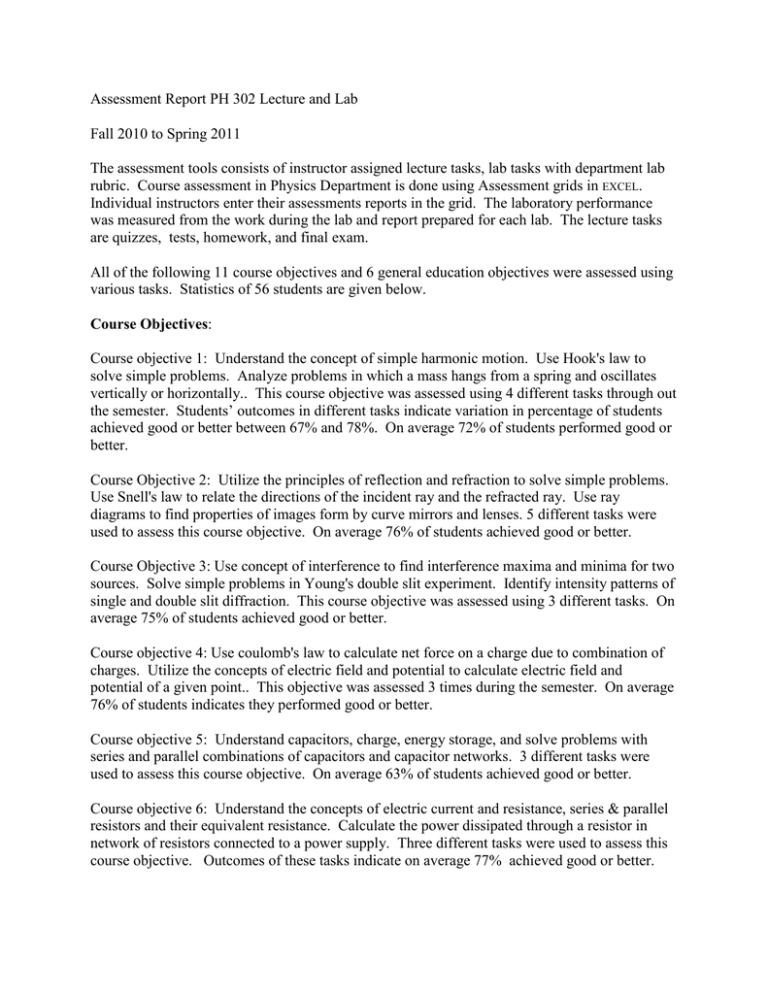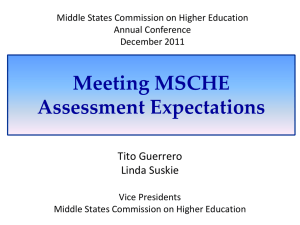Assessment Report PH 302 Lecture and Lab
advertisement

Assessment Report PH 302 Lecture and Lab Fall 2010 to Spring 2011 The assessment tools consists of instructor assigned lecture tasks, lab tasks with department lab rubric. Course assessment in Physics Department is done using Assessment grids in EXCEL. Individual instructors enter their assessments reports in the grid. The laboratory performance was measured from the work during the lab and report prepared for each lab. The lecture tasks are quizzes, tests, homework, and final exam. All of the following 11 course objectives and 6 general education objectives were assessed using various tasks. Statistics of 56 students are given below. Course Objectives: Course objective 1: Understand the concept of simple harmonic motion. Use Hook's law to solve simple problems. Analyze problems in which a mass hangs from a spring and oscillates vertically or horizontally.. This course objective was assessed using 4 different tasks through out the semester. Students’ outcomes in different tasks indicate variation in percentage of students achieved good or better between 67% and 78%. On average 72% of students performed good or better. Course Objective 2: Utilize the principles of reflection and refraction to solve simple problems. Use Snell's law to relate the directions of the incident ray and the refracted ray. Use ray diagrams to find properties of images form by curve mirrors and lenses. 5 different tasks were used to assess this course objective. On average 76% of students achieved good or better. Course Objective 3: Use concept of interference to find interference maxima and minima for two sources. Solve simple problems in Young's double slit experiment. Identify intensity patterns of single and double slit diffraction. This course objective was assessed using 3 different tasks. On average 75% of students achieved good or better. Course objective 4: Use coulomb's law to calculate net force on a charge due to combination of charges. Utilize the concepts of electric field and potential to calculate electric field and potential of a given point.. This objective was assessed 3 times during the semester. On average 76% of students indicates they performed good or better. Course objective 5: Understand capacitors, charge, energy storage, and solve problems with series and parallel combinations of capacitors and capacitor networks. 3 different tasks were used to assess this course objective. On average 63% of students achieved good or better. Course objective 6: Understand the concepts of electric current and resistance, series & parallel resistors and their equivalent resistance. Calculate the power dissipated through a resistor in network of resistors connected to a power supply. Three different tasks were used to assess this course objective. Outcomes of these tasks indicate on average 77% achieved good or better. Course objective 7: Understand the Ohm's law and Kirchhoff's laws. Use these laws to solve simple circuit problems. Understand the proper use of voltmeters and ammeters. Three different tasks were used to assess this course objective. Outcomes of these tasks indicate 65%, 72% and 93 % achieved good or better. Course objective 8: Understand the concept of magnetic force acting on charge particle moving in magnetic field or current wire placed in a magnetic field. Use Ampere's law to calculate magnetic field due to long current wires. Understand the concept of electro-magnetic induction and use Faraday's and Lenz's laws to calculate induced e.mfs. Two different tasks were used to assess this course objective. Outcomes of these tasks indicate 64% achieved good or better. Course Objective 9: Understand the RC circuit time constant and solve problems of charging and discharging the RC circuit with networks of resistors and capacitors. Two different tasks were used to assess this course objective. Outcomes of these tasks indicate 77% , 65% and 93 % achieved good or better. Course Objective 10: Perform experiments as described in the rubrics and draw meaningful conclusions from data and present them as part of a clear, well-organized lab report. This course objective was assessed using 14 different tasks through out the semester. Students’ outcomes in different tasks indicate variation in percentage of students achieved good or better between 80% and 95%. On average 93% of students performed good or better. Gen. Ed. Objectives: Gen. Ed. Objective #3: Write, read, listen and speak clearly and effectively This Gen. Ed. objective was assessed using 6 different tasks through out the semester. Students’ outcomes in different tasks indicate variation in percentage of students achieved good or better between 66% and 83%. On average 77% of students performed good or better. Gen. Ed. Objective #4. Use analytical reasoning skills and apply logic to solve problems. This Gen. Ed. objective was assessed using 6 different tasks through out the semester. Students’ outcomes in different tasks indicate variation in percentage of students achieved good or better between 76% and 93%. On average 80% of students performed good or better. Gen. Ed. Objective #5: Use quantitative skills and mathematical reasoning to solve problems. This Gen. Ed. objective was assessed using 6 different tasks through out the semester. Students’ outcomes in different tasks indicate variation in percentage of students achieved good or better between 56% and 83%. On average 70% of students performed good or better. Gen. Ed. Objective #9: Use personal and collaborative skills for personal growth and to establish constructive relationships in a diverse society This Gen. Ed. objective was assessed using 6 different tasks through out the semester. Students’ outcomes in different tasks indicate variation in percentage of students achieved good or better between 80% and 95%. On average 93% of students performed good or better. Summary: Course objectives and 4 of the Gen. Ed. Objectives were assessed using various tasks. Some objectives were assessed using multiple tasks. Each objective were assessed at least twice. Outcomes indicate 70% or more achieved good or excellent. This level of student performance is acceptable for a challenging course like 302. Recommendations: Each task measure several objectives and at the same time certain objectives can be assessed in different tasks. It is useful to measure the performance of students in each objective within a specific task.





